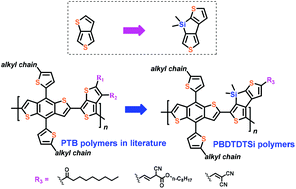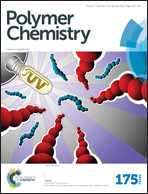Novel dithienosilole-based conjugated copolymers and their application in bulk heterojunction solar cells†
Abstract
Three asymmetrical dithienosilole monomers with different electron withdrawing groups (nonanoyl group, octyl cyanoacetate or malononitrile) were synthesized and a series of silicon containing conjugated polymers (PBDTDTSi-1, PBDTDTSi-2 to PBDTDTSi-3) were prepared from these asymmetrical dithienosilole building blocks via microwave assisted polymerization. Density functional theory (DFT) quantum chemistry calculations were employed for the optimization of molecular structures, deep understanding of the electronic structures and their photophysical properties. When these polymers were utilized as the donor materials for polymer solar cells (PSCs), the influence of side chains on the photovoltaic performance was investigated and all the polymers presented high open-circuit voltage above 1.0 V. PSCs with a blend of PBDTDTSi-1:PC71BM (1 : 4, by weight) as the active layer showed the highest power conversion efficiency of 3.29%, with an open-circuit voltage of 1.07 V, a short-circuit current density of 7.53 mA cm−2, and a fill factor of 0.41. Our research revealed that the variation of substituents on the dithienosilole moieties had a great influence on the morphology of blend films and charge carrier mobilities, which are crucial to the performance of PSCs.



 Please wait while we load your content...
Please wait while we load your content...